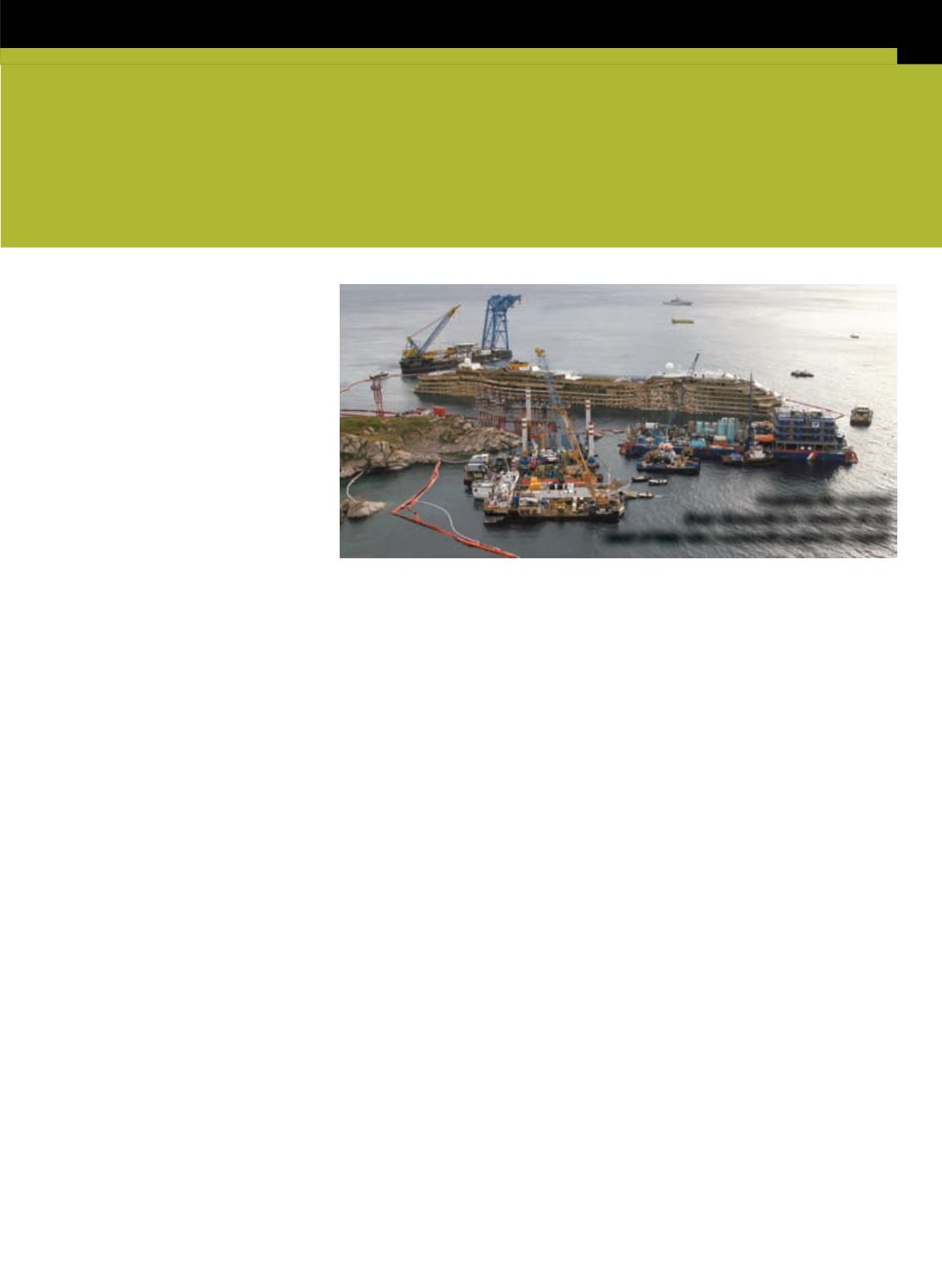
JOBSOF THE YEAR
SC&RA
51
MAY 2014
ACT
>52
T
he accident thatwrecked and
partially sank the cruise ship
CostaConcordia
in January2012
garneredworldwidemedia attention. The
wrecked vessel, partiallyunderwater and
restingon its side against a rock ledge,
was adismal sight off the scenic coast of
IsolaDelGiglio, Italy. Thepriority for
the ship’s owner, CostaCrociere, was the
removal of thewreck inonepiece, an
expensive and complicatedproject.
Fagioliwas awarded the jobbyTitan
Salvage inpartnershipwith the Italian
Micoperi consortium, a contract for the
CostaConcordiawreck removal project
equipment and logistics support under
theoverall project coordinationofCosta
Crociere.
Thewreck recoveryplanwas divided
into four basic steps, each that involved
expert engineering anddetailedplanning.
The stepswere anchoring and stabilizing
the ship; preparing a false, subseabottom;
theparbucklingoperation; and finally
surveyof thewreck and installationof
sponsons.
The first step, stabilization, was carried
out by securing four anchor blocks to
the seabottombetween the center of the
wreck and the coast bymeans of 16300 to
450-ton capacity strand jacks positioned
on thewreck. Sevenmore anchor blocks
and12 towerswere installed to secure
thepositionof thewreckkeel during
the rotation. The 12 sets of Fagioli tower
lift and strand jack systems (L600 jacks
positionedon topof each tower)were
combined toperform the stabilization.
Next a falsebottomwas preparedon the
seabed for the ship to rest on after itwas
rotated. The subseaplatforms, comprised
of 1,180 removable grout bagsweighing
more than16,000 tons, provided a stable
base for the vessel.
Eleven large floating tanks, known as
sponsons andweighingup to500 tons
each, werepositionedon theport side
of the ship.Usinggantry cranes,mobile
cranes and48 axle lines of SPMTs, Fagioli
provided the equipment for the loadout,
load in and rotationupsidedownof the
sponsons. After installing the sponsons,
phasebymeans of ballastingof the
sponsons and jacks. At the endof the
final phase thewreckwould complete 64
degrees rotation andwould rest on the
falsebottomplatform at adepthof 30
meters.
The constraints of this operation
werehuge, as thiswas the first time an
operation like this hadbeenperformed
on a cruise ship thatwas 300meters
long andweighed114,000 tons. Safety
was ahuge component inplanning. It
tookmore than a year to study, plan
andperform theoperation. Fagioliwas
involved in almost every element of
theproject, ranging from calculations,
risk assessment,methodof statements,
procedures and in the road and sea
transport of all the equipment.
The jobwas dramatically influenced
byweather and sea conditionswith the
riskof losing thewreck, or in theworst
case, sinking it. The strand and tower
lift positioningwas critical, as the ship
rested a fewmeters from rockswhere it
was impossible toposition the tower. The
foundations of the towerwere installed in
the seabedbyprofessional seadivers.
“Thiswas a job significantly influenced
by thedramatic events that occurred to
thewreck, and therewas apsychological
pressure everyday after the accident
by theworldwidemedia,” saidFagioli’s
EdoardoAscione. “Itwas aunique
operation thatwas followedbymillions of
people around theworld.”.
■
Fagioli rigged36 strand jacks on topof
thenine sponsons on the starboard side
of thewrecked ship. This iswhen things
got tedious anddangerous.
Thepower packunits (PPUs) used to
allow the 36 jacks toworkduring the
parbucklingoperations needed tobe
placedon thewreck, whichmeant during
theduration, thePPUs not anchored
as the strand jacks couldhave created
a large-scale stabilityproblem. To face
this issue, Fagioli’s teamdecided touse
two swingingplatforms installedonto
the tallest sponsons, equippedwith
generators andPPUs. This allowed the
PPUs to remain stable at thehighest
water levels during the rotation. To
providebuoyancy and stabilization, two
blister tankswere installed at thebowof
the shipby the client.
Huge safety concerns
To assure safety in thework area, Fagioli
completed the connectionof all the
electronic andhydraulic components
in a control roompositionedon abarge
clear of thework area. The strand jacks
were remotely controlled from the control
roomduring the rotationoperation.
Inmid-September 2013 theparbuckling
operationbeganwith threemainphases:
detaching thewreck from the spurs of
rocks onwhich it rested; the rotation
phase inducedby strand jacks until the
vessel rotated approximately25degrees
from its initial position; and the rotation
RIGGINGOVER$750,000
Cruise ship salvage
Fagioli
Preparing thewrecked
Costa Concordia
for removal off the
coast of Italywas amammoth project for Fagioli.


